|
|
|
Sort Order |
|
|
|
Items / Page
|
|
|
|
|
|
|
| Srl | Item |
| 1 |
ID:
147315
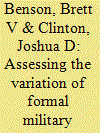

|
|
|
|
|
| Summary/Abstract |
Many critical questions involving the causes and consequences of formal military alliances are related to differences between various alliances in terms of the scope of the formal obligations, the depth of the commitment between signatories, and the potential military capacity of the alliance. Studying the causes and consequences of such variation is difficult because while we possess many indicators of various features of an alliance agreement that are thought to be related to the broader theoretical concepts of interest, it is unclear how to use the multitude of observable measures to characterize these broader underlying concepts. We show how a Bayesian measurement model can be used to provide parsimonious estimates of the scope, depth, and potential military capacity of formal military alliances signed between 1816 and 2000. We use the resulting estimates to explore some core intuitions that were previously difficult to verify regarding the formation of the formal alliance agreement, and we check the validity of the measures against known cases in alliances as well as by exploring common expectations regarding historical alliances.
|
|
|
|
|
|
|
|
|
|
|
|
|
|
|
|
| 2 |
ID:
187393


|
|
|
|
|
| Summary/Abstract |
The comparative study of atrocities and atrocity prevention faces several obstacles including a lack of consensus on the universe of cases and too few cases to statistically test alternative theories. The brutality-based (BB) conception is based on the idea that widespread, state-led violations of physical integrity rights constitute an assault on the personhood and human dignity of the members of society— a mass atrocity. Applying this idea to all countries annually systematically identifies a larger number of atrocities and facilitates categorization into three levels of intensity. The BB methodology for generating annual atrocity lists is replicable and transparent. The findings show that, between 1981 and 2019, the frequency of atrocities as defined and identified by other projects has been decreasing, but BB atrocities have been increasing. The sequence of different types of widespread physical integrity violations suggests new avenues for research on atrocity occurrence, escalation, de-escalation, and cessation.
|
|
|
|
|
|
|
|
|
|
|
|
|
|
|
|
| 3 |
ID:
128946


|
|
|
|
|
| Publication |
2014.
|
| Summary/Abstract |
In this article we set out a fine-grained measure of the formal authority of intermediate subnational government for Indonesia, Malaysia, the Philippines, South Korea, and Thailand that is designed to be a flexible tool in the hands of researchers and policymakers. It improves on prior measures by providing annual estimates across ten dimensions of regional authority; it disaggregates to the level of the individual region; and it examines individual regional tiers, asymmetric regions, and regions with special arrangements. We use the measure and its elements to summarize six decades of regional governance in Southeast Asia and conclude by noting how the Regional Authority index could further the dialogue between theory and empirics in the study of decentralization and democratization.
|
|
|
|
|
|
|
|
|
|
|
|
|
|
|
|
| 4 |
ID:
169136


|
|
|
|
|
| Summary/Abstract |
It appears that an almost unquestioned development pathway for achieving gender equity and women's empowerment has taken centre stage in mainstream development. This pathway focuses on economic outcomes that are assumed to be achieved by increasing women's access to material things, including cash income, loans, physical assets, and to markets. Gender equity indicators, which measure progress towards these outcomes, cannot escape reinforcing them. We argue that far from being neutral, indicators are embedded in political and ideological agendas that serve as guides to the appropriate conduct of those whose performance or behaviour is being measured. Drawing on participatory feminist, diverse economies and strengths based approaches, we outline a research methodology for developing community‐based indicators that recognises women's and men's participation and relationships in all spheres of life, including the ‘non‐economic’. If indicators are grounded in local meanings and realities, we propose that community members can use them to identify aspirational goals for gender equity, and measure progress towards these goals.
|
|
|
|
|
|
|
|
|
|
|
|
|
|
|
|
| 5 |
ID:
182679


|
|
|
|
|
| Summary/Abstract |
One way nuclear agreements might keep signatories from proliferating is by constraining nuclear capacity. Theoretical work on nonproliferation often points to such constraints as an important driver of nonproliferation success. Some have argued that, absent sufficient constraint, states with the desire and capability to proliferate will do so. Faced with more costly routes to a weapon, states subject to technological constraint may abide by the terms of the deal. This perspective poses an important empirical question: do nonproliferation agreements result in significant technological constraint in practice? This article evaluates the empirical prevalence of constraints arising from nonproliferation deals. Doing so requires (1) providing an appropriate measure of nuclear proficiency and (2) developing an estimate of the counterfactual, no-agreement capacity of states that received such agreements. This study addresses both of these points. First, new data are gathered to estimate proficiency, improving upon existing measures in the literature. Second, the generalized synthetic control method is applied to estimate counterfactual proficiency levels for the recipients of agreements. With this approach, the constraining effects of deals the United States implemented with Japan, South Korea, and Taiwan and the Declaration of Iguaçu between Brazil and Argentina are evaluated. The findings indicate that the constraining effect of these nonproliferation agreements is minimal.
|
|
|
|
|
|
|
|
|
|
|
|
|
|
|
|
| 6 |
ID:
102757
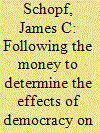

|
|
|
| 7 |
ID:
175705
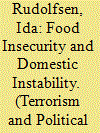

|
|
|
|
|
| Summary/Abstract |
Research on the relationship between food insecurity and unrest has a long history. The food price spikes in 2007–2008 and 2010–2011 coincided with demonstrations and incidents of large-scale violence, prompting renewed scholarly interest in the link between food insecurity and unrest. This paper reviews the literature, synthesises its main empirical findings and central explanations, and identifies four particular issues to consider to enhance our understanding of how food insecurity is related to unrest. First, there is a wide range of suggested theoretical mechanisms of how food insecurity is linked to unrest, but the empirical tests are akin. Second, there exist various notions of the independent variable, but there is a gap between the theoretical definition and measurement. Third, the focus is often on “food riots”, but whether rioting is the most likely response, and whether it is possible to separate between “food-related” unrest and other types of turmoil is unclear. Lastly, there is a challenge to address the endogenous nature of food insecurity and unrest. The paper adds to the literature by pointing to the theoretical mechanisms linking food insecurity to unrest, relating both to the type and degree of food insecurity, and how we understand and define unrest.
|
|
|
|
|
|
|
|
|
|
|
|
|
|
|
|
| 8 |
ID:
108124


|
|
|
|
|
| Publication |
2011.
|
| Summary/Abstract |
With the view of becoming an innovation-driven nation by 2020, national innovation capacity (NIC) building has become a key issue for China to transform its development pattern. A series of fundamental questions, such as how to build NIC and what roles should the government play, are faced by both the government and academia. The current literature concerning NIC mainly focuses on measurement and determinant analysis, which cannot give direct and sufficient support to policy making. This paper tries to fill the gap between theoretical analysis of NIC and policies for building NIC by proposing a conceptual framework, in which the inherent connections between innovation capacity indicators and policy options for building NIC are investigated. Policy measures for building NIC in China are discussed in the end of this paper.
|
|
|
|
|
|
|
|
|
|
|
|
|
|
|
|
| 9 |
ID:
086754


|
|
|
|
|
| Publication |
2009.
|
| Summary/Abstract |
While government turnover is often thought of as an adverse source of instability, it may also be viewed as a favourable source of competition and institution-building. To articulate and test such hypotheses, this article describes two main concepts of government turnover: leadership turnover, or change in rulers, and ideological turnover, or change in the rulers' ideology. Refinements involve the mode, outcome and timing of turnover. The article discusses measurement issues that arise when there are multiple power institutions and when parliaments are controlled by changing majority coalitions. The measures of turnover are illustrated by examining the post-communist world. The article considers the possibility that higher cumulative post-transition turnover - in terms of leaderships or ideologies - has assisted in establishing the rule of law.
|
|
|
|
|
|
|
|
|
|
|
|
|
|
|
|
| 10 |
ID:
176045
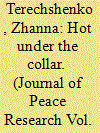

|
|
|
|
|
| Summary/Abstract |
The majority of studies on international conflict escalation use a variety of measures of hostility including the use of force, reciprocity, and the number of fatalities. The use of different measures, however, leads to different empirical results and creates difficulties when testing existing theories of interstate conflict. Furthermore, hostility measures currently used in the conflict literature are ill suited to the task of identifying consistent predictors of international conflict escalation. This article presents a new dyadic latent measure of interstate hostility, created using a Bayesian item-response theory model and conflict data from the Militarized Interstate Dispute (MID) and Phoenix political event datasets. This model (1) provides a more granular, conceptually precise, and validated measure of hostility, which incorporates the uncertainty inherent in the latent variable; and (2) solves the problem of temporal variation in event data using a varying-intercept structure and human-coded data as a benchmark against which biases in machine-coded data are corrected. In addition, this measurement model allows for the systematic evaluation of how existing measures relate to the construct of hostility. The presented model will therefore enhance the ability of researchers to understand factors affecting conflict dynamics, including escalation and de-escalation processes.
|
|
|
|
|
|
|
|
|
|
|
|
|
|
|
|
| 11 |
ID:
128963


|
|
|
| 12 |
ID:
121276


|
|
|
|
|
| Publication |
2013.
|
| Summary/Abstract |
Many pre-existing air conditioner load control programs can provide valuable operational flexibility but have not been incorporated into electricity ancillary service markets or grid operations. Multiple demonstrations have shown that residential air conditioner (AC) response can deliver resources quickly and can provide contingency reserves. A key policy hurdle to be overcome before AC load control can be fully incorporated into markets is how to balance the accuracy, cost, and complexity of methods available for the settlement of load curtailment. Overcoming this hurdle requires a means for assessing the accuracy of shorter-term AC load control demand reduction estimation approaches in an unbiased manner. This paper applies such a method to compare the accuracy of approaches varying in cost and complexity - including regression analysis, load matching and control group approaches - using feeder data, household data and AC end-use data. We recommend a practical approach for settlement, relying on an annually updated set of tables, with pre-calculated reduction estimates. These tables allow users to look up the demand reduction per device based on daily maximum temperature, geographic region and hour of day, simplifying settlement and providing a solution to the policy problem presented in this paper.
|
|
|
|
|
|
|
|
|
|
|
|
|
|
|
|
| 13 |
ID:
171803
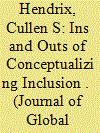

|
|
|
|
|
| Summary/Abstract |
In the field of global security studies, inclusion, both in terms of process and outcomes, is certainly having a moment. Like many terms widely adopted by the international security and development communities, the utility of the discourse around inclusion stems in part from its ambiguity. The various contributions to this special issue make good and productive use of this ambiguity and have moved the discussion of inclusive approaches to governance, violence reduction, and peace-building forward. In doing so, however, they have put forth very different conceptualizations and operationalizations of inclusion and exclusion. Thus, my contribution to this symposium identifies these various conceptualizations, discusses the strengths and weaknesses of proposed measures, and concludes with remarks on the normative implications of these analyses.
|
|
|
|
|
|
|
|
|
|
|
|
|
|
|
|
| 14 |
ID:
113536
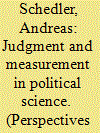

|
|
|
|
|
| Publication |
2012.
|
| Summary/Abstract |
Standard methodological advice in political science warns against the distortion of measurement decisions by judgmental elements. Judgment is subjective, common wisdom asserts, it produces opaque, biased, and unreliable data. This article, by contrast, argues that judgment is a critical intersubjective ingredient of political measurement that needs to be acknowledged and rationalized, rather than exorcised.
|
|
|
|
|
|
|
|
|
|
|
|
|
|
|
|
| 15 |
ID:
176042
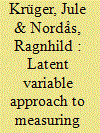

|
|
|
|
|
| Summary/Abstract |
Conflict-related sexual violence is an international security problem and is sometimes used as a weapon of war. It is also a complex and hard-to-observe phenomenon, constituting perhaps one of the most hidden forms of wartime violence. Latent variable models (LVM) offer a promising avenue to account for differences in observed measures. Three annual human rights sources report on the sexual violence practices of armed conflict actors around the world since 1989 and were coded into ordinal indicators of conflict-year prevalence. Because information diverges significantly across these measures, we currently have a poor scientific understanding with regard to trends and patterns of the problem. In this article, we use an LVM approach to leverage information across multiple indicators of wartime sexual violence to estimate its true extent, to express uncertainty in the form of a credible interval, and to account for temporal trends in the underlying data. We argue that a dynamic LVM parametrization constitutes the best fit in this context. It outperforms a static latent variable model, as well as analysis of observed indicators. Based on our findings, we argue that an LVM approach currently constitutes the best practice for this line of inquiry and conclude with suggestions for future research.
|
|
|
|
|
|
|
|
|
|
|
|
|
|
|
|
| 16 |
ID:
169444
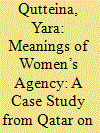

|
|
|
|
|
| Summary/Abstract |
The measurement of women’s agency poses numerous challenges, including multi-dimensionality and context-specificity. This challenge is especially large for non-Western contexts that adapt measurement instruments without rigorous testing and comprehensive understanding of construct meanings in place. In this paper, we present a case study from Qatar where we investigate the face validity, comprehension and functionality of women’s agency scale items. Cognitive interviews were conducted with twenty-four women to capture their interpretations of decision-making, freedom-of-movement, and gender attitudes scale items. The majority of women originally reported that they made their own decisions; yet, further probing revealed otherwise. While women seemed to understand, as intended, the freedom-of-movement item, the items measuring gender attitudes were generally reflective of broader local societal norms rather than the women’s own opinions. This research highlights the need for deeper exploration into women’s understanding of an agency scale before its use in a new context.
|
|
|
|
|
|
|
|
|
|
|
|
|
|
|
|
| 17 |
ID:
139220
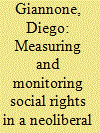

|
|
|
|
|
| Summary/Abstract |
The article aims to describe how the measurement and monitoring of human rights have been changed and weakened by the neoliberal resistance to social rights. In so doing, the study describes the political and ideological context which stimulated the broad conception of human rights included in the Universal Declaration of Human Rights. It then focuses on the ideological turn which occurred over the 1970s from welfare democracy to neoliberal democracy and the neoliberal approach to human rights. Based on a neo-Gramscian approach, the study considers political and ideological reasons as key in explaining both the rise and fall of social rights and the changes in their measurement. As a case in point, the article analyses the work of the UN in measuring and monitoring human rights. In spite of the use by the UN committees of indicators and guidelines aimed at measuring and monitoring the progressive realization of all human rights, results show that the reluctance of many states to implement social and economic rights makes UN efforts ineffective. Both states’ reluctance and instruments’ ineffectiveness can be ascribed to the neoliberal delegitimization of social rights, which is likely to persist in spite of the recent economic crisis.
|
|
|
|
|
|
|
|
|
|
|
|
|
|
|
|
| 18 |
ID:
149881
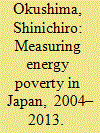

|
|
|
|
|
| Summary/Abstract |
This paper first examines energy (or fuel) poverty in Japan from 2004 to 2013, especially around the time of the 2011 Great East Japan Earthquake (GEJE). To analyze the issue, the paper employs various poverty and vulnerability measures with the assistance of our unique dataset. The results indicate the aggravation of energy poverty among lower-income and vulnerable households during the past decade, resulting from both the escalation of energy prices and lowering of income. The analysis also employs a new decomposition technique and identifies the explanatory factors associated with the increase in energy poverty. These results suggest there were major changes in the forces driving the increase in energy poverty before and after the GEJE. After 2011, income alleviates energy poverty in Japan, with energy prices becoming the main driving factor.
|
|
|
|
|
|
|
|
|
|
|
|
|
|
|
|
| 19 |
ID:
183698
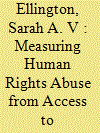

|
|
|
|
|
| Summary/Abstract |
Existing measures of human rights abuses are often only available at the country-year level. Several more fine-grained measures exhibit spatio-temporal inaccuracies or reporting biases due to the primary sources upon which they rely. To address these challenges, and to increase the diversity of available human rights measures more generally, this study provides the first quantitative effort to measure human rights abuses from textual records of citizen-government interactions. Using a dataset encompassing over 1.5 million access-to-information (ATI) requests made to the Mexican federal government from June 2003 onward, supervised classification is used to identify the subset of these requests that pertain to human rights abuses of various types. The results from this supervised machine learning exercise are validated against (i) gold standard ATI requests pertaining to past human rights abuses in Mexico and (ii) several accepted external measures of sub-national and sub-annual human rights abuses. In doing so, we demonstrate that the measurement of human rights abuses from citizen-submitted ATI request texts can provide measures of human rights abuse that exhibit both high validity and notable spatio-temporal specificity, relative to existent human rights datasets and variables.
|
|
|
|
|
|
|
|
|
|
|
|
|
|
|
|
| 20 |
ID:
086209
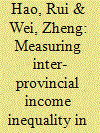

|
|
|
|
|
| Publication |
2009.
|
| Summary/Abstract |
China's regional inequality is a hotly debated topic in the literature, but the fundamental issue of measurement has somehow escaped from the deliberations. In this paper, we select several commonly used income indicators, inequality indices and concepts to measure China's inter-provincial inequality and compare the results. We find China's inter-provincial inequality is very sensitive to different measurements. These sensitivity analyses help us to understand the ongoing debates on China's regional income inequality. We also conduct a cross-country comparison to illustrate the broad ranking of China's regional inequality in the world. We find that China's regional inequality appears not to be as high as usually perceived, despite approaching an alarming level.
|
|
|
|
|
|
|
|
|
|
|
|
|
|
|
|
|
|
|
|
|